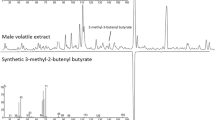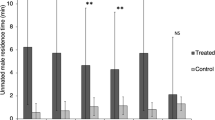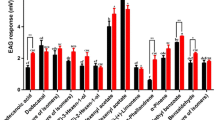Abstract
Field studies of male Oriental fruit moth,Grapholitha molesta (Busck), behavior indicated that a mixture of cis-8-dodecenyl acetate (c8-12∶Ac) and ca. 7% trans-8-dodecenyl acetate (t8-12∶Ac) was requisite for upwind anemotaxis. The simultaneous emission of dodecyl alcohol (12∶OH) and the attractant blend of c8-12∶Ac containing ca. 7% t8-12∶Ac elicited a behavioral repertoire including close-range orientation, landing near the chemical source, wing fanning, and extrusion of the males' abdominal hairpencils in precopulatory display. The effect of 12∶OH in increasing trap catches was, therefore, not due to its effect on upwind anemotaxis, but rather to its importance in eliciting landing and other close-range precopulatory behavior. Interestingly, cis-8-dodecen-1-ol in extremely low ratios to the attractants (1∶333) appeared to duplicate the activity of 12∶OH used in ratios of 3∶1 to the attractants. Laboratory observations of mating sequences revealed that male hairpencil eversion always preceded copulation. The evidence supports a male response sequence based on specific component combinations and concentrations eliciting successive behavioral steps rather than a response hierarchy dependent on increases in concentration of a single chemical or blend. Additionally, the closeness of the males' approach to c8-12:Ac containing ca. 7% t8-12:Ac was optimal at a discrete emission rate, and male responses were diminished within 30–60 sec after the males' arrival at the attractant source.
Similar content being viewed by others
References
Baker, J.L., Hill, A.S., Cardé, R.T., Kurokawa, A., andRoelofs, W.L. 1975. Sex pheromone trapping of the omnivorous leafroller,Platynota stultana.Environ. Entomol. 4:90–92.
Beroza, M., Gentry, C.R., Blythe, J.L., andMuschik, G.M.. 1973a. Isomer content and other factors influencing captures of Oriental fruit moth by synthetic pheromone traps.J. Econ. Entomol. 66:1307–1311.
Beroza, M., Muschik, G.M., andGentry, C.R. 1973b. Small proportion of opposite geometrical isomer increases potency of synthetic pheromone of Oriental fruit moth.Nature 244:149–150.
Birch, M.C. 1974. Aphrodisiac pheromones in insects, pp. 115–134,in M.C. Birch (ed.),Pheromones. North Holland Publ. Co., Amsterdam.
Cardé, R.T., Baker, T.C., andRoelofs, W.L. 1975a. Behavioural role of individual components of a multichemical attractant system in the Oriental fruit moth.Nature 253:348–349.
Cardé, R.T., Trammel, K., andRoelofs, W.L. 1975b. Disruption of sex attraction of the redbanded leafroller(Argyrotaenia velutinana) with microencapsulated pheromone components.Environ. Entomol. 4:448–450.
Comeau, A. 1971. Physiology of sex pheromone attraction in Tortricidae and other Lepidoptera (Heterocera). Ph.D. Thesis, Cornell University, Ithaca, New York.
George, J.A. 1965. Sex pheromone of the Oriental fruit moth,Grapholitha molesta (Busck) (Lepidoptera: Tortricidae).Can. Entomol. 97:1002–1007.
Kaae, R.S., Shorey, H.H., andGaston, L.K. 1973. Pheromone concentration as a mechanism for reproductive isolation between two lepidopterous species.Science 179:487–488.
Kennedy, J.S. 1972. The emergence of behaviour.J. Aust. Entomol. Soc. 11:168–176.
Kennedy, J.S., andMarsh, D. 1974. Pheromone-regulated anemotaxis in flying moths.Science 184:999–1001.
Roelofs, W.L., andCardé, R.T. 1974a. Oriental fruit moth and lesser appleworm attractant mixtures refined.Environ. Entomol. 3:586–588.
Roelofs, W.L., andCardé, R.T. 1974b. Sex pheromones in lepidopterous species, pp. 96–114,in M.C. Birch (ed.),Pheromones. North Holland Publ. Co., Amsterdam.
Roelofs, W.L., Comeau, A., andSelle, R. 1969. Sex pheromone of the Oriental fruit moth.Nature 224:723.
Roelofs, W.L., Cardé, R.T., andTette, J. 1973. Oriental fruit moth attractant synergists.Environ. Entomol. 2:252–254.
Rothschild, G.H.L. 1974. Problems in defining synergists and inhibitors of the Oriental fruit moth pheromone by field experimentation.Entomol. Exp. Appl. 17:294–302.
Schwinck, I. 1955. Weitere Untersuchungen zur Frage Geruchsorientierung der Nachtschmetterlinge: Partielle Fühleramputation bei Spinnermännchen, insbesondere am SeidenspinnerBombyx mori L. Z. Vergl. Physiol. 37:439–458.
Author information
Authors and Affiliations
Rights and permissions
About this article
Cite this article
Cardé, R.T., Baker, T.C. & Roelofs, W.L. Ethological function of components of a sex attractant system for oriental fruit moth males,Grapholitha molesta (Lepidoptera: Tortricidae). J Chem Ecol 1, 475–491 (1975). https://doi.org/10.1007/BF00988588
Received:
Revised:
Issue Date:
DOI: https://doi.org/10.1007/BF00988588




